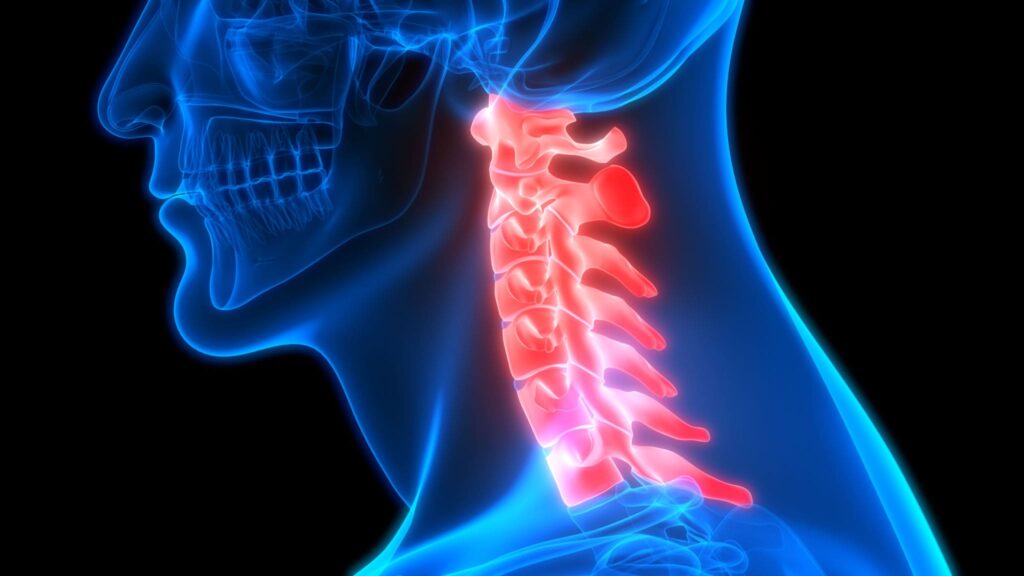- (213) 369-4583
- Monday - Friday
- 9 am - 5 pm
Cervical Spine Injury: Symptoms, Causes, Treatments, and Recovery

Jul 26, 2022
The cervical spine is the top area of the human spine. It consists of the first seven (C1 - C7) out of the total 33 vertebrae, separated by intervertebral discs. Any injury in this part causes pain around the neck region. However, not all kinds of neck pain necessarily mean that there is a cervical spine injury as the symptoms of such pain are quite different. An injury to the cervical spine is generally treated with cervical spine surgery. This article will cover both sides - symptoms, and treatments of cervical spine injury. In addition to this, you will also get to know about the rehabilitation process after the surgery. By the time you finish reading, you will be in a better position to understand if you are suffering from cervical spine injury and how you can go about treating it.
Visit Southern California Brain & Spine Surgery and see Dr. Moksha Ranasinghe: A top spine surgeon in Los Angeles. Schedule an appointment now!
Symptoms of Cervical Spine Injury
The following symptoms indicate that the neck pain one experiences is due to an injury or deformity in the Cervical Spine.
- Dull or sharp neck pain that radiates from the neck down to the arms, hands, and fingers. The pain is usually accompanied by numbness and tingling in the shoulder or arm.
- Like with any other spine injury, loss of bladder and bowel control, difficulty breathing, and impaired balance are also observed in people with a cervical spine injury.
- Pain that worsens when you bend forward or twist your neck
- Pain that worsens with coughing or sneezing
- Sensitivity to touch in the neck, shoulders, and upper back
- Tenderness and/or loss of range of motion in one or both arms and/or legs
Causes of Cervical Spine Injury

According to the National Library of Medicine, causes of Cervical Spine Injuries can be classified into two types; Traumatic and Nontraumatic.
Traumatic Injuries
Trauma is one of the most common causes of injury to the spinal cord. A traumatic injury occurs due to a motor accident, falling, sport-related injuries, etc. Acute cervical spine trauma can cause grave injuries to the muscles, ligaments, and spinal cord. In some cases, spine discs get ruptured or displaced causing radiating pain and tingling in the arms and shoulders.
Nontraumatic Injuries
Over time, spine discs get degenerated due to wear and tear. Such damage to the spinal discs is nontraumatic however, it can cause a great deal of pain. Non-Traumatic causes of cervical spine damage also include osteoporosis, arthritis, or inflammation of the spinal cord.
Diagnosing Cervical Spine Injury
There are different tests doctors use to diagnose spinal cord injuries:
- Sensory Examination - Ability to sense hot, cold, pressure, touch, and pain near the affected area.
- Motor Examination - This examination includes testing of a range of motion under no, little, and high resistance. The doctor grades the patient according to his/her situation.
- Reflex Examination - In these tests, doctors check how well the autonomic system of the body is behaving.
- Imaging Tests - After finding the symptoms of spinal injury, the doctor will have you go for scans like an X-ray or MRI. These imaging tests help confirm the injury to the spinal cord and spot the cause.
Treatments for Cervical Spine Injury
Depending upon the severity of the damage, patient’s age, overall health condition, preference, and some other factors, the doctor will recommend surgical or nonsurgical treatments.
Nonsurgical Treatments for Cervical Spine Injury
Most spine injuries, if not traumatic, can be treated with nonsurgical procedures. For example, neck pain due to cervical disc herniation can be cured with conservative treatments and surgery can be avoided. These methods include;
- To go on a brief bed rest
- Reducing physical activities that put stress on the cervical spine
- Physical therapy and massage
- Medication to reduce pain and inflammation
- Use of spinal braces or soft cervical collar to keep the spine in shape
- Exercises to improve the range of motion
Surgical Treatments for Cervical Spine Injury
If patients do not show any improvement after being given nonsurgical treatments, the doctors prepare them for surgery. Depending upon the specifics of each case, the doctors can utilize different surgical procedures for treatment. Nevertheless, whichever surgical method is used, the goals are the same;
- Relieving neck pain
- Stabilizing the spine
- Improving range of motion
- Correcting spine alignment
- Remove compression from the spinal cord or nerves
Generally, surgeons would use three types of procedures to fix cervical spine deformities;
1. Cervical Discectomy and Fusion
Cervical discectomy can be performed using two approaches; Anterior and Posterior. Both approaches are quite similar except for the fact that in Anterior Discectomy, the surgeon approaches the cervical spine from the front i.e., throat, and in Posterior discectomy, an incision is made at the back of the neck. In both surgical procedures, herniated or degenerative discs are removed. The approach to be used is determined by the surgeon based on the condition of the case.
Once the damaged part of the disc is removed, it is followed by spinal fusion to stabilize the spine. The basic idea of spinal fusion is to fill the gap created as a result of disc removal. For spinal fusion, surgeons use some bone material known as a bone graft. This material serves as a support to the vertebrae.
2. Cervical Laminectomy
Laminectomy is different from discectomy in a way that it is performed when the back of the vertebrae is damaged. So, in a laminectomy procedure the bony part covering the spinal cord is removed, whereas, in discectomy, part of the herniated or degenerative disc is removed. Laminectomy is commonly used to treat bone spurs of the spine associated with arthritis. During the operation, the surgeon removes the lamina relieving the pressure from the spinal cord and nerves. It is also followed by a cervical spinal fusion surgery that fills the gap created due to the removal of bone and makes the spine stable.
3. Cervical Disc Replacement Surgery
In Cervical Disc Replacement surgery, unlike Spinal Fusion in which vertebrae are fused, doctors replace the damaged disc with an artificial one. No bone graft is used, instead, the surgeon puts a new disc in place of the old one. It is considered to be a better procedure than fusion surgery as it preserves the mobility and motion of the spine.
Risks and Complications Involved
Surgical spine treatments are to be carried out with extreme care and skill. According to research published by NIH, there are more than 10 risks associated with Cervical Spine Injury. These include; Adjacent Segment Disease, Leakage of Cerebrospinal fluid (CSF), Infection, Dysphagia, and Hematoma. Therefore, it is always recommended to consult a senior and expert neurosurgeon when it comes to getting invasive spine treatment. Discussed below are the details of some of the common risks involved in Cervical Spine Surgery;
Adjacent Segment Disease - In some cases of cervical spinal fusion surgery, patients can develop adjacent segment disease after the surgery. It is because in cervical fusion, two or more vertebrae are fused and this can influence the natural stability of the spine. As a result, discs adjacent to the fused vertebrae can be under greater stress to keep the spine together. This condition is known as adjacent segment disease. It can be normally treated with conservative procedures but in some cases, a second surgery might be needed to fix the problem.
Cervical Spine Infection - Mostly, infections occur at the surgical site within two to three days of the surgery. Infection is caused due to the bacteria that spreads to vertebrae from the blood. Experiencing chronic neck pain, fever, and dysphagia after the surgery are some common symptoms of post-surgical infection.
Hematoma - This is when blood accumulates in the tissues of the body and can be caused by bleeding within the spinal column or from any other injury on the spine. Hematomas can occur after any type of spinal surgery and are more likely to happen if there was any previous damage to the discs or nerves in your back before surgery.
Post-operative Care of Cervical Spine Surgery
Post-operative care of cervical spine surgery is essential to maintain the healing process and prevent complications. The surgical site should be kept clean, dry, and covered with a sterile dressing after surgery.
Rest - The patient should rest comfortably in the prone position until they can turn over and sit up without assistance.
Diet - They should drink plenty of water, eat nutritious meals and take pain medication according to their prescribed regimen.
If they have undergone a cervical fusion with hardware, then traction may be required for several weeks following surgery to help prevent contracture of the fused vertebrae.
Activity - Patients should be encouraged to sit up and start moving their necks slowly within a few days after surgery. This will help prevent stiffness in the neck muscles and reduce pain because it helps warm up the tissues around the area of treatment.
The most important thing is to follow all of the advice given by the medical staff. This will ensure that you get the best possible results from your operation. If there are any questions or concerns about your case, then you must speak to your surgeon about them as soon as possible so that they can advise on any further treatment required.
Recovery after Cervical Spine Surgery
Rehabilitation after a spine surgery requires great discipline in terms of staying physically active and following the doctor’s instructions. The goal of rehabilitation is to regain full strength in your neck muscles so that you can perform daily activities without pain.
- After spine surgery, you will need to take it easy for a few weeks or months. This is the time when your body heals itself and starts to recover from the effects of the surgery.
- Start with mild physical activities like walking and then slowly progress towards strenuous exercises.
- Once the incisions have healed, massage can be a great rehabilitation option after spine surgery
- We would also suggest seeing physical therapists for a comfortable recovery. They will put you on programs that include special exercises targeting the muscles around your neck.
See a Spine Surgeon in Los Angeles for Cervical Spine Surgery
Spine diseases are not to be taken lightly. You need only the best of the best spine surgeons for any problem related to your back.
If you happen to be in Los Angeles and suffering from any spine condition, you can visit Southern California Brain & Spine surgery. We have the reputation of being the best spine treatment medical facility in Los Angeles. Doctors and staff here provide dedicated care to patients suffering from spine and brain problems. You get specialized care with a holistic approach from diagnosis to recovery. Schedule your appointment by filling out the contact form or calling us at 213-369-4583.




